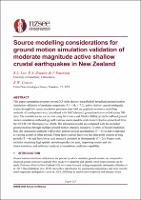| dc.contributor.author | Lee, Robin | |
| dc.contributor.author | Bradley, Brendon | |
| dc.contributor.author | Paterson, James | |
| dc.contributor.author | Graves, Robert | |
| dc.date.accessioned | 2020-06-18T13:53:58Z | |
| dc.date.available | 2020-06-18T13:53:58Z | |
| dc.date.issued | 2020-04-22 | |
| dc.identifier.uri | https://repo.nzsee.org.nz/xmlui/handle/nzsee/1735 | |
| dc.description.abstract | This paper summarises progress toward NZ-wide physics-based hybrid broadband ground motion simulation validation of moderate magnitude (5.0 < Mw < 7.0), active shallow crustal earthquake events through low spatial resolution prototype runs with an emphasis on source modelling methods. 62 earthquakes were considered with 1692 observed ground motion recorded across 200 sites. The simulations are carried out using the Graves and Pitarka (2016) hybrid broadband ground motion simulation methodology with various source models, and crustal velocities prescribed from the NZVM 2.0 (Thomson et al. 2020). The simulation results are compared with the recorded ground motions through multiple ground motion intensity measures. In terms of model prediction bias, the simulations perform well at short period spectral accelerations (T < 0.3s) and overpredict to varying extents at other periods. Finite faults sources have less bias than point sources at long periods (T > 4s) and have lower total standard deviation at short periods (T < 2s). Future work includes simulating high spatial resolution production runs, improving source and site characterisation, and additional analyses of simulation predictive capability. | |
| dc.language.iso | en | |
| dc.publisher | New Zealand Society for Earthquake Engineering | |
| dc.relation.ispartofseries | 2020;125 | |
| dc.subject | Engineering seismology | |
| dc.title | Source modelling considerations for ground motion simulation validation of moderate magnitude active shallow crustal earthquakes in New Zealand | |
| dc.type | Article | |

